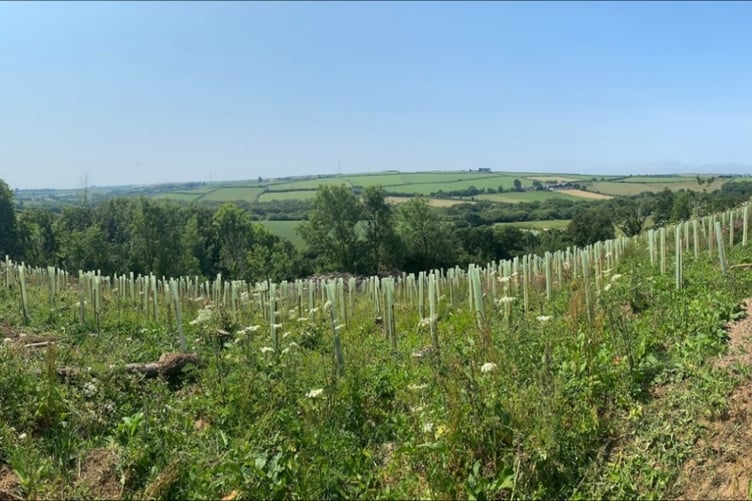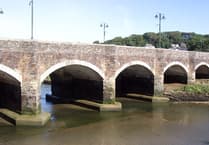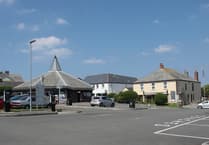A National Highways-funded green initiative to protect and enhance biodiversity alongside the A30 in Cornwall has just completed.
As part of its Designated Funding programme, National Highways has provided Cornwall Wildlife Trust with £1.02-million to restore and recreate 15.5 hectares of woodland, orchard, grassland and heathland around Ladock to Gwills and Benhaven to Lambourne Mill, north of Truro.
As part of the environmental initiative, a total of 15,000 trees have been planted within the mid-Cornwall landscape, including species such as scots pine, oak, lime, chestnut, sycamore and blackthorn near Idless Woods in the upper Truro catchment.

The company has joined Cornwall Wildlife Trust, Cornwall Council and Environment Agency partners to celebrate the conclusion of the Green Ribs projects.
The Environment Agency also provided £50,000 from the Water Environment Investment Fund towards the initiative, along with £50,000 from the Shared Prosperity Fund - administered by Cornwall Council, which will help to tackle decreasing biodiversity within the county’ by: creating and enhancing habitat areas for wildlife; improving the quality, condition and connectivity of landscape features in Cornwall; mitigating severance impacts of the A30 by creating stronger habitat connections, safely channelling wildlife away from the road.
National Highways project manager, Jess Dudley, said “We’re delighted to see our funding realise these environmental projects, which will bring long-lasting benefits for Cornwall.
“Roadside verges and nearby land and wetlands alone are home to a diverse array of plants, animals and natural habitats, and through both our work and funding, we are committed to reversing the decline in biodiversity, helping wildlife thrive and building in environmental resilience to a changing climate.
“Working with Cornwall Wildlife Trust, Cornwall Council and local landowners, we’re really proud of the work undertaken to protect and enhance the ecology and environment around the mid-Cornwall landscape. The support from local landowners involved in the project has been fantastic and without them this wouldn’t be possible.
“The initiative will provide a real biodiversity benefit and is a glowing example of how our funding and partnership working can make life better for communities, wildlife and the environment around our roads.”
The completion of the Green Ribs work builds on previous design and construction work within the first roads investment, particularly between Benny Mill and Boswiddle, and includes a robust after-care programme.

The first phase of the work achieved recognition from CIEEM (Chartered Institute of Ecology and Environmental Management) with a best practice award for stakeholder engagement.
Cornwall Council and Natural England jointly funded initial technical work ahead of the National Highways investment and the council has also been steering development to align with its nature recovery, climate resilience and Forest for Cornwall ambitions.
The final phase of the programme included planting of species-rich grassland and trees, along with wet meadow, pond and wet habitat restoration and boundary work.
Tom Shelley, conservation manager for Cornwall Wildlife Trust, said: “It’s great to mark the completion of the Green Ribs project and the investment in the Cornish landscape will help grow habitats and protect existing nature networks.
“This is helping to restore biodiversity and also allows neighbouring landowners to have a combined positive impact in the long term. This is a key part of the Trust’s strategic plan for at least 30% of Cornwall’s land and sea to be connected, recovering and protected for nature by 2030.”
The nearby A30 Chiverton to Carland Cross scheme has also been designed to protect the environment and as part of construction, a total of 33 multi-species crossing points, including a ‘green bridge’ at Marazanvose, the third of its kind in the country, are being constructed to assist the habitats and journeys of animals such as otters, badgers, bats and reptiles.
The scheme will also see more than 28 miles of new drainage to protect the local area and water courses, new filtration ponds, native tree planting, the creation of new landscape boundaries and the construction of earth barriers and sound-absorbing fencing.
National Highways manages four designated funds to deliver benefits above and beyond building, maintaining and operating England’s strategic roads.
From protecting the environment and enhancing the landscape around roads, to improving safety, reducing congestion, and supporting communities, the aim is to make a positive difference to people’s lives.
Coinciding with the United Nations Biodiversity Day on May 22, National Highways is marking Nature Week, highlighting the nature-focused work it and its partners do around the country.
National Highways says it is on course to achieve its 2020 commitment of halting the decline of biodiversity and achieving no net loss in biodiversity across its activities by 2025.
In the next five years it will make a further move toward becoming nature positive by delivering at least a 10 per cent net gain in biodiversity on its major projects and moving towards a no net loss position for the soft estate between 2025 and 2030.




.jpg?width=209&height=140&crop=209:145,smart&quality=75)
Comments
This article has no comments yet. Be the first to leave a comment.